The State of the Race, Two Months Out
Harris leads for now but signs of a close race persist.
It’s getting late early. With Labor Day in the rearview mirror, there are now just over two months to go until Election Day. The Harris and Trump campaigns have begun stepping up their campaign activity in the swing states, and the first mail ballots go out in North Carolina this week. As the home stretch of this campaign approaches, let’s take a look at where the race stands—in the national popular vote, in the Electoral College, and with various segments of the electorate.
The National Picture
One of the most striking developments in the Biden-Trump rematch this year was the fact that Trump, who never led in the national popular vote in 2020, had been consistently ahead of Biden throughout much of this year. The reason this mattered, as we’ve previously documented, is that Biden’s 8.5-point lead in the national polling average four years ago overestimated his final performance by four points, leading to a much narrower-than-expected Electoral College win. Thus, for Trump to be leading Biden this time portended potential disaster for the incumbent president.
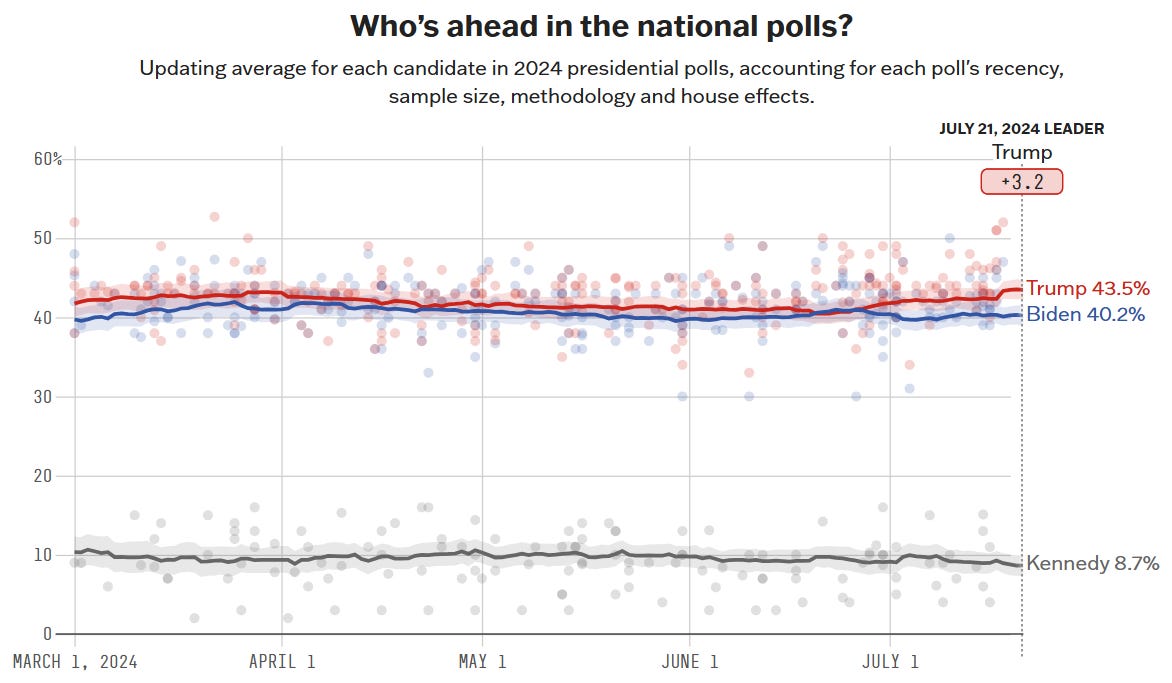
Since Biden bowed out and Kamala Harris took his place, however, that picture has been inverted. Over the past month and a half, Harris has steadily gained in the national polls and quickly surpassed Trump, whose own polling position has remained virtually unchanged at roughly 43.6 percent. This was a sign that Harris was likely picking up support among disaffected Democrats, third-party voters, and undecideds.1 It also indicated Trump may have a firm ceiling.
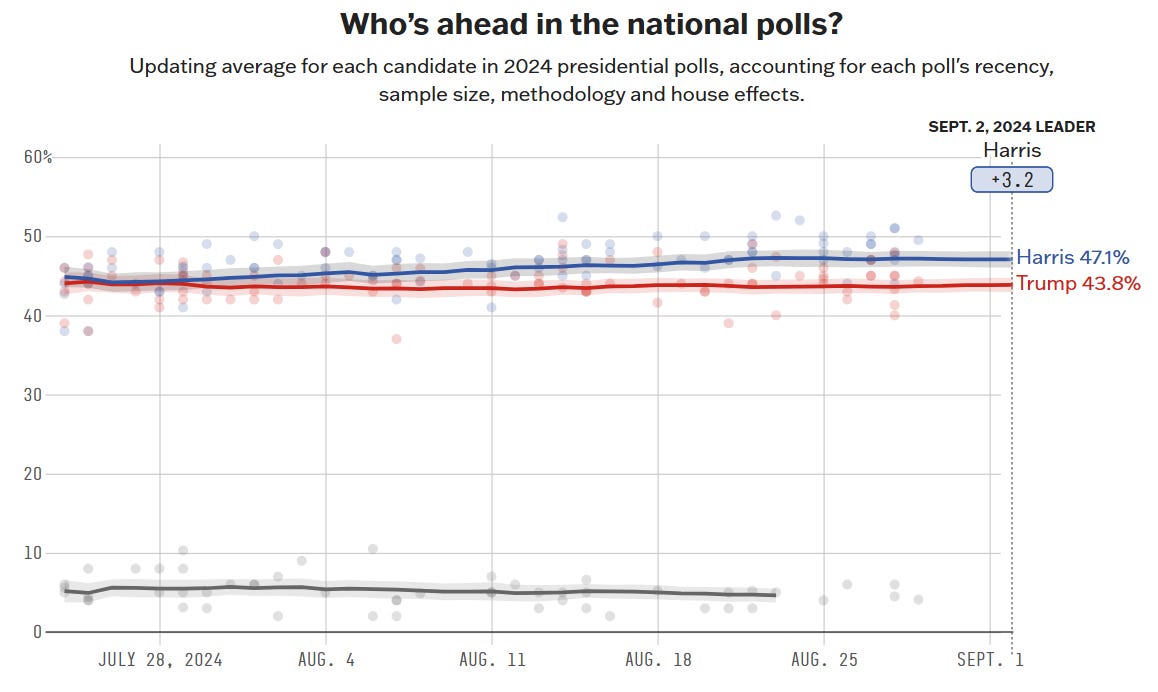
As of this week, Harris’s national lead sits at 3.2 points, mirroring Hillary Clinton’s pre-election polling lead in 2016, no doubt an ominous sign for the Harris camp. If she maintains this lead through Election Day but does not improve—her gains have noticeably tapered off over the past couple of weeks—it’s unclear whether it will be enough to withstand another polling error in Trump’s favor (which, of course, isn’t guaranteed to happen again). Still, she’s in a much better place today than Biden was in late July, and in politics, it’s always better to be ahead than behind.
The Electoral College Puzzle
Since the turn of the century, the Electoral College has grown noticeably less competitive, and this cycle unlikely to deviate from that trend. Most analysts consider the only true toss-up states to be the seven that were decided by fewer than three points in 2020: Arizona, Georgia, Michigan, Nevada, North Carolina, Pennsylvania, and Wisconsin, all of which went for Biden except North Carolina.
Overall, Democrats are undeniably in a much better position today than they were a little over a month ago. Before Biden dropped out of the race, he was trailing Trump in every single swing state and barely holding on in places like Minnesota and Virginia, both of which supported him by healthy margins last time. According to the final polling conducted before he bowed out, here’s what the Electoral College picture looked like:
This essentially resembles a repeat of Trump’s 2016 win, but he would have added Nevada to his column as well. However, Harris has clawed back much of the ground Biden had been losing in the battleground state polls and turned several of them in her favor. Based on the latest polling averages, here’s how the Electoral College would look if the election were held today:2
As things stand, Harris is positioned to win the Electoral College by a slightly smaller margin than Biden, with Trump favored to win back Georgia and retain North Carolina.
Still, the race remains close. Remember that in 2020, Biden won the Electoral College by only about 45,000 votes across three states, where his final margins over Trump were between just 0.2 and 0.3 points. And it’s with this in mind that Harris’s current lead looks slightly more precarious. Although she leads Trump in five of the seven battleground states, her advantage in them is no larger than 2.2 points (Michigan). This means Trump is a normal polling error away from winning all of the below states in which Harris is favored except Minnesota.
Given the constricted nature of the electoral map this cycle, it’s less likely that we’ll see Harris, specifically, do much better than Biden, with the possible exception of flipping North Carolina. Meanwhile, any gains for Trump will probably be limited to those other six states—and possibly Virginia, too.
How Key Groups Are Performing
Harris is also better-positioned with most factions of the electorate than Biden was by the end of his campaign. The lone exception is white college-educated voters, who backed both of them by 11 points this year (a two-point improvement on Biden’s 2020 performance). Moreover, she is outpacing him with some core groups compared to four years ago, including Democrats (+3) and white voters (+5)—specifically, white non-college voters (+4). She also appears to be doing better among rural voters, though there is some reason to be skeptical about this.3
However, Trump is also better positioned among some key constituencies today. Perhaps the most shocking shift has been the movement toward him among black Americans. After Biden won these voters by 81 points in 2020, his margin with them was down to 52 at the end of July, constituting a whopping 29-point swing in Trump’s direction. Harris has regained some of that ground, but she continues to trail Biden’s 2020 margins by a full 21 points. She is also still underperforming him among young voters (-9), Hispanics (-13), independents (-10), and voters living in urban areas (-12).
The good news for Harris is that she has continued making inroads with many of the groups she has been underperforming with. Using crosstab aggregation data from pollster Adam Carlson, we know that compared to the first month of her campaign, Harris has improved her standing by four points each with men, black voters, and seniors—all crucial voting blocs—over the last week and a half. She has also gained three more points with Democrats. By contrast, though, she has lost two points among Hispanics and, perhaps even more troubling, four points with independents.
Mirroring trends in the national popular vote and Electoral College, Harris has clearly given her party a boost among several demographic groups. What remains to be seen is whether she (1) continues inching back toward historical Democratic margins with black, Hispanic, young, and urban-dwelling voters, and (2) retains her current gains with white voters and seniors.
We live in an era when national elections are increasingly decided by fewer and fewer voters, which can make them more unstable—even the most minor of shifts in the electorate can swing an election. For now, Kamala Harris is well positioned to win the presidency this November, likely with a relatively narrow electoral-vote margin. As we saw over the summer, though, a month is an eternity in politics; anything can happen between now and November. So, while Harris may be the current favorite, her victory is far from guaranteed.
Note in the charts above and below the drop in Robert F. Kennedy, Jr.,’s standing after Harris entered the race.
Battleground state polling averages are derived using data from FiveThirtyEight and the New York Times.
Data for this section comes from an average of four datasets: the Edison Research exit poll, the AP VoteCast survey, Catalist’s “What Happened” report, and Pew Research’s validated voter analysis. If we exclude the Edison exit polls, which most practitioners consider the weakest of the four datasets, the other three each found Trump winning rural voters by about 33 points rather than the smaller 28 points indicated in this section’s table. This would mean Harris has gained nearly the same amount with rural voters (11 points) that she has lost with urban voters (12 points), a highly unlikely development given recent electoral trends.


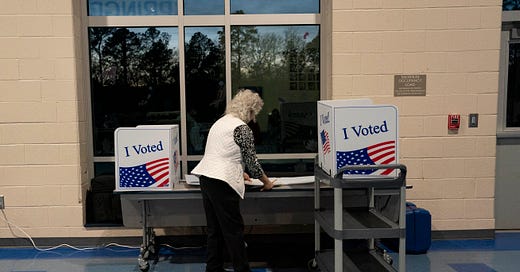




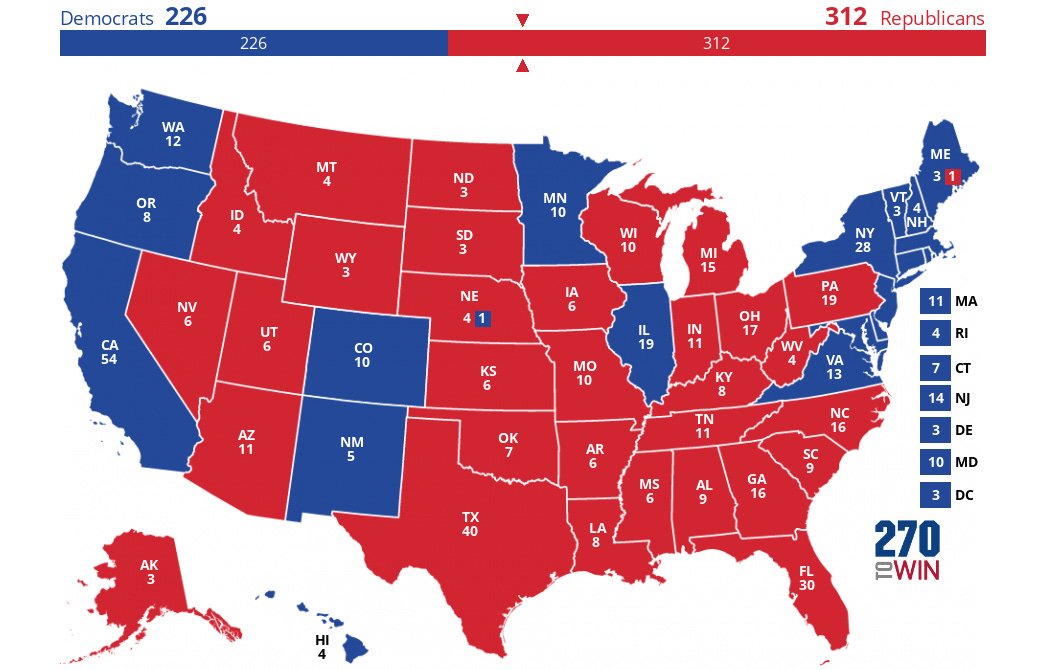
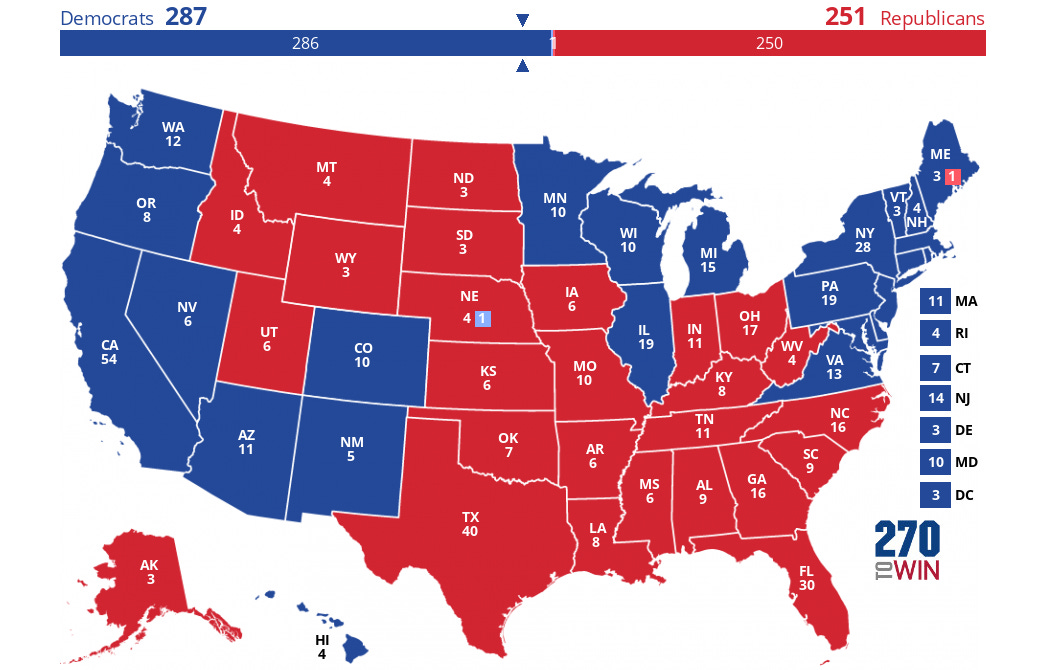
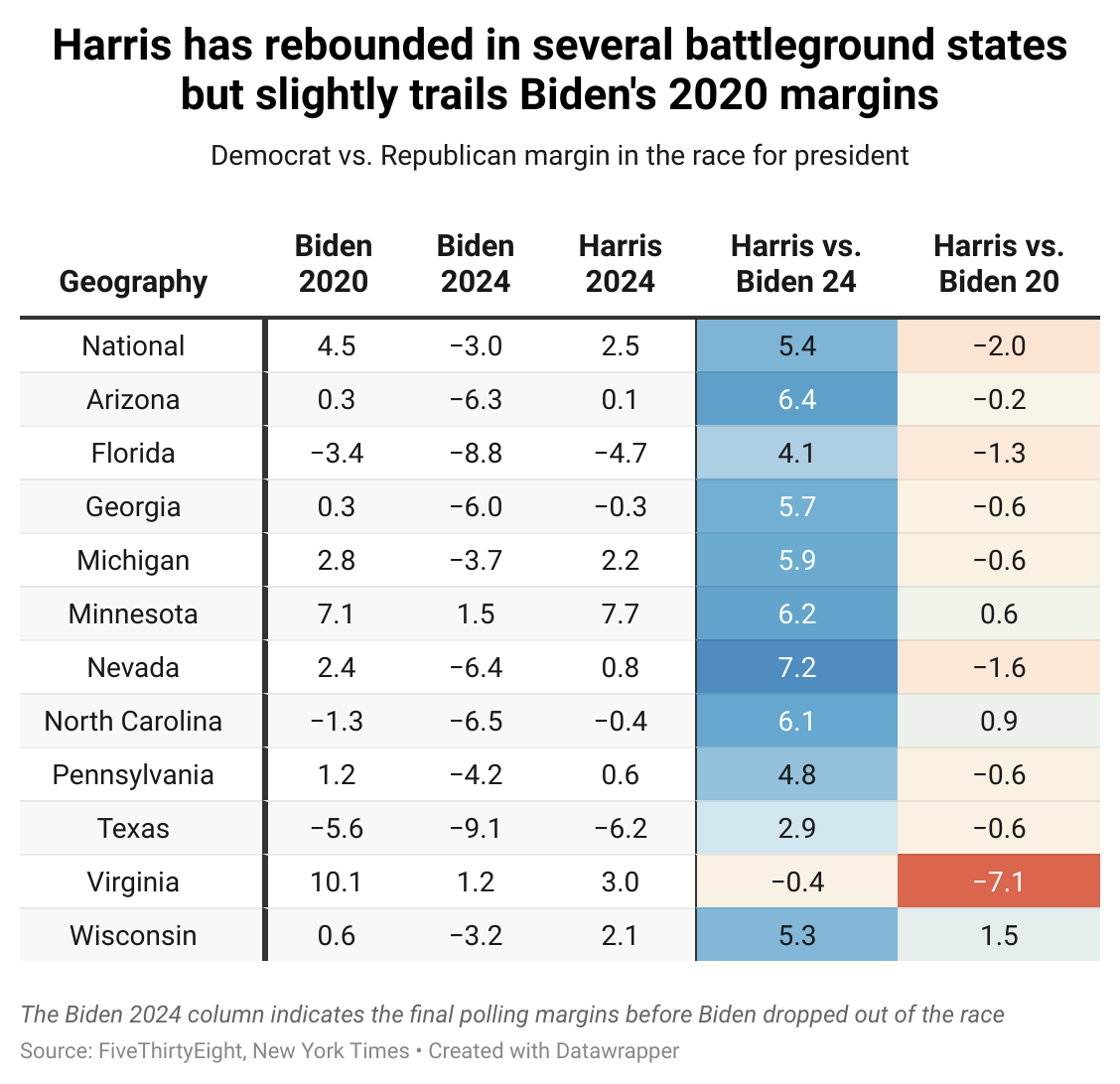
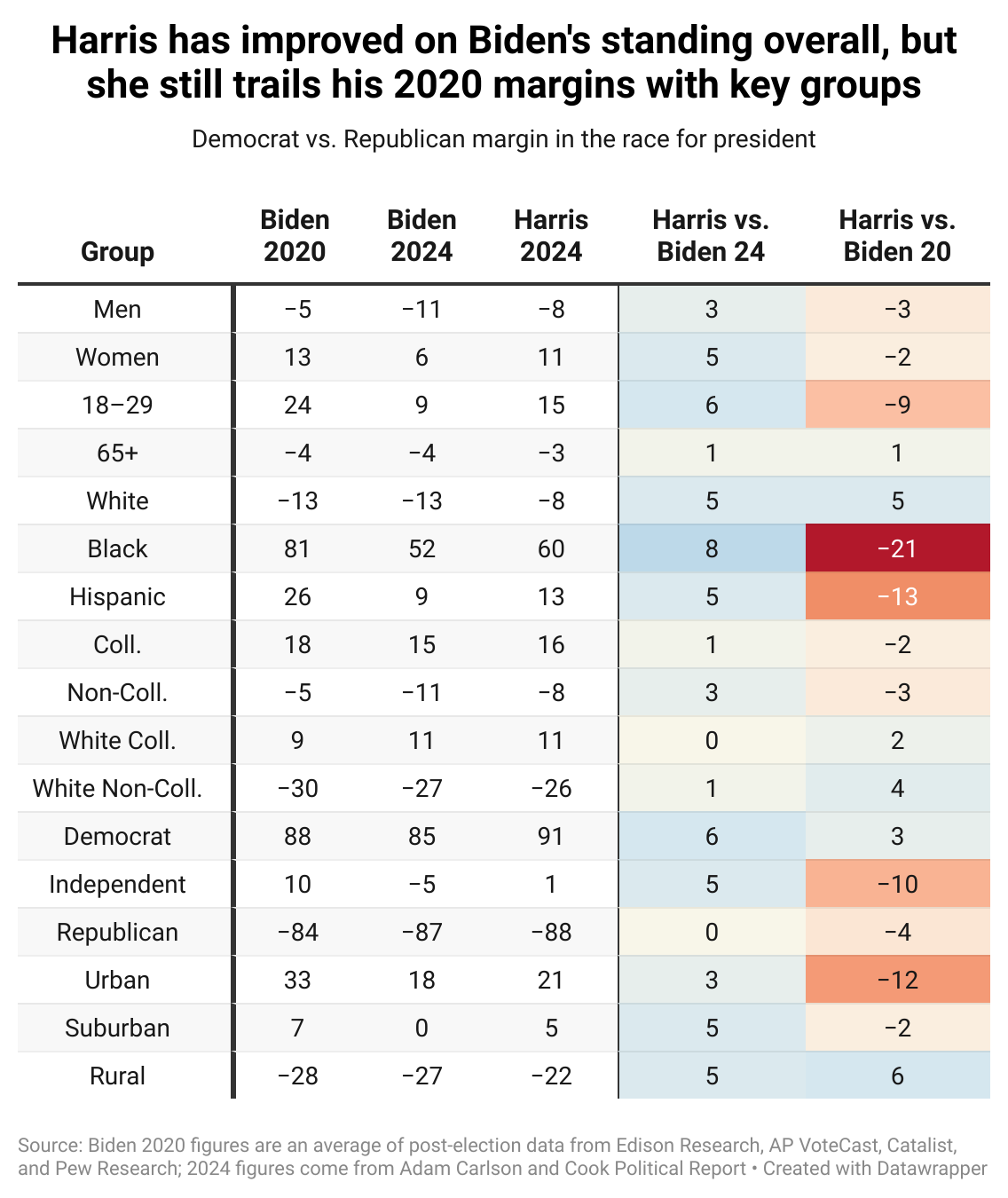
Ruy, very solid review of the polling. But the biggest indicators are non polling:
*Since 2020, of the 30 states where you can track voter registration by party, Republicans net gained in . . .
EVERY. SINGLE. STATE..
Some of this data is off the charts. In Marixopa Co., AZ, the GOP now has a 160,000 net lead over Ds---more than the whole STATE lead in 2020. New state data is due out any day, but last time I looked Rs had a quarter million state wide lead. Now all but Pima Co. (Tucson) is red, and even Pima saw D registration NET declines.
Places such as NC and PA have seen dramatic slashes in the D majority (Trump won NC both in 2016 and 2020 with a larger D majority). Repeat after me: NC and AZ are not swing states.
PA has, like AZ, seen a significant R registration surge. But even in places such as NE2, where Biden won by 22,000, Rs have chopped that edge by 2/3, gaining net 13,000. NV, IA, OH, ME all showing similar trends.
*Another non-polling critical indicators is early ballots requested. Biden dominated these votes in 2020 (many would use the word "fraud" here)) but in GA (which does not register by party) the #s are don 90%. (Biden won that by 30% of his 10,000 edge). JUST in the requested early votes the Ds have already lost GA. But the same is true in PA, where early vote ballot requests are down 30%.
And don't forget the GOP this time had its own push for early ballot requests, so a GOOD portion of all those reduced numbers will be Rs, not Ds.
*TargeteSmart or some such group posted an idiotic stat that since Harris's installation black female registration was up "133%." Well, maybe in Rwanda or Benin, but not in the U.S. Again, in NC where we can actually measure this by party AND race, total NEW black registrations: 3,000. Total new white registrations, 12,000. If anything, Harris is driving MORE whites than ever to register.
*You mentioned one of the most important factors of all: Trump's polling is ALWAYS behind his actual vote getting. This is particularly true at the state level. Ds are ALWAYS over polled. Consider in 2020 Richard Baris had Biden +10 in MN. Baris is considered one of the most "conservative" (I'd say, "accurate") pollsters out there. Reality? Biden+2 in MN. Polls consistently had Trump at +4 in OH in 2016 and 2020. Reality? +8 and +8.5. He'll be closer to 9 this cycle. Polls have Trump at +2 in FL. Given that now FL has an 800,000 R voter reg edge vs. deficit in 2020, Trump will win FL by 7-10. No, FL is not a swing state. WHATEVER state you pick, Trump underpolls.
So bottom line, the national polls are juiced, but they won't stay that way. Harris is already sinking fast, particularly in state polls. Only bit uber-prog areas like CA and NY, meaningless for the electoral college, are propping her up. When you look outside of polling, Trump will win the popular vote and will win the EC comfortably by 312-340 range. But Harris is just bad enough she could flip still other states to Trump/Vance/RFK
A very solid, informative review and analysis of the current polling. Thanks!
Overall, it looks moderately positive for Harris, so I'm glad about that.